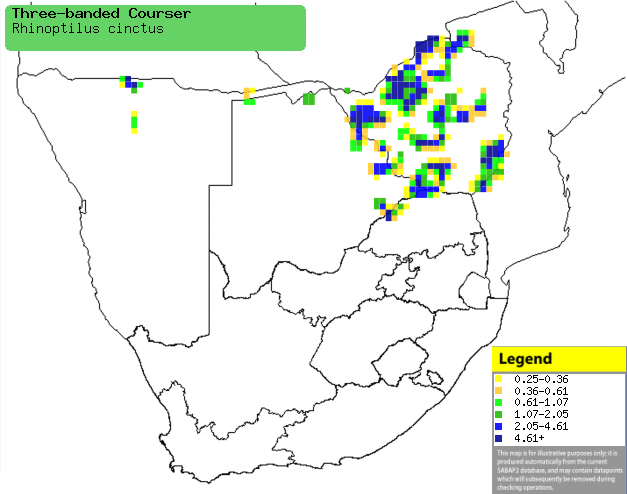|
Rhinoptilus cinctus (Three-banded
courser)
Driebanddrawwertjie [Afrikaans]; Driebandrenvogel [Dutch];
Courvite à triple collier [French]; Bindenrennvogel [German];
Corredor-de-três-golas [Portuguese]
Life
> Eukaryotes >
Opisthokonta
> Metazoa (animals) >
Bilateria >
Deuterostomia > Chordata >
Craniata > Vertebrata (vertebrates) > Gnathostomata (jawed
vertebrates) > Teleostomi (teleost fish) > Osteichthyes (bony fish) > Class:
Sarcopterygii (lobe-finned
fish) > Stegocephalia (terrestrial
vertebrates) > Tetrapoda
(four-legged vertebrates) > Reptiliomorpha > Amniota >
Reptilia (reptiles) >
Romeriida > Diapsida > Archosauromorpha > Archosauria >
Dinosauria
(dinosaurs) > Saurischia > Theropoda (bipedal predatory dinosaurs) >
Coelurosauria > Maniraptora > Aves
(birds) >
Order: Charadriiformes > Family: Glareolidae
Distribution and habitat
Occurs from Ethiopia and Somalia through Kenya, Tanzania,
Zambia and southern Angola to southern Africa. Within southern Africa it is locally common in
Zimbabwe, northern Namibia, eastern Botswana and Limpopo Province. It generally prefers dry, open Mopane (Colosphermum mopane) woodland, as well as miombo (Brachystegia)
woodland, arid savanna and habitats with open patches created by African
elephants (Loxodonta africana).
|
 |
|
Distribution of Three-banded courser in southern
Africa, based on statistical smoothing of the records from first SA Bird
Atlas Project (©
Animal Demography unit, University of
Cape Town; smoothing by Birgit Erni and Francesca Little). Colours range
from dark blue (most common) through to yellow (least common).
See here for the latest distribution
from the SABAP2. |
Movements and migrations
Not well understood, it is thought to be
predominantly resident in southern Africa. However, it has been
suggested that this population is supplemented by an influx of non-breeders from up
north in late summer and early spring.
Food
Its diet has not been studied, but it probably mainly
consists of insects, foraging nocturnally and often along dirt roads.
Breeding
- Probably a monogamous solitary nester, digging a deep scrape in the ground
beneath a bush or tree, lined with gravel, friable soil and small twigs.
- Egg-laying season is from April-November, peaking from August-October.
- It lays two eggs, which are incubated by both sexes for about 25-27 days,
in shifts of roughly 90-120 minutes.
- The chicks leave the nest within 24 hours of hatching, remaining with
their parents beyond the end of the breeding season.
Threats
Not threatened, as there is no evidence that its range has
contracted, although destruction of Acacia woodland in Zimbabwe is cause
for concern.
References
-
Hockey PAR, Dean WRJ and Ryan PG 2005. Roberts
- Birds of southern Africa, VIIth ed. The Trustees of the John Voelcker
Bird Book Fund, Cape Town.
|
